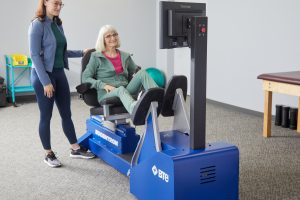-

Pinch strength plays a crucial role in daily tasks, from self-care to sports, yet it often goes unnoticed until weakness sets in. This article explores the importance of pinch strength, effective exercises to improve it, and advanced rehabilitation tools like the PrimusRS that enhance therapy outcomes.
-

Learn how to measure hand grip strength, track progress, and enhance therapy outcomes with personalized grip strength exercises. Enhance injury recovery, build strength, and help patients regain functional abilities with the PrimusRS' advanced grip strength testing and treatment protocols.
-

“To really get where we need to [in balance training], you need to add the interactive factor, the neurological benefits, and the visual stimulation,” says Sims. According to Sims, the Alfa balance training equipment provides visual stimulation, promotes high repetition, increases patient engagement, eliminates compensation patterns, and fosters neuroplasticity.
-

Eccentric training is transforming Parkinson's disease rehabilitation by addressing motor challenges with groundbreaking results. Discover how high-intensity eccentric resistance training can improve strength, mobility, and quality of life for PD patients. Learn about the latest research and practical strategies for physical and occupational therapists.
-

Explore the world of fun, effective, and evidence-based therapeutic gaming devices like you've never seen before. Discover how engaging exercises promote neuroplasticity and transform your hand therapy practice, featuring Q&A from our recent webinar with ASHT.
-

Learn how to do the Unterberger Test, interpret results, and enhance your balance assessments with data-driven balance assessment devices.
-

Nearly every plan of care will focus on strengthening the injured area, whether knee, ankle, elbow, and every other joint in the body. Shouldn't cervical spine rehabilitation follow suit? Learn how neck strengthening tools can relieve neck pain, improve cervical spine injury recovery, and promote long-term health.





